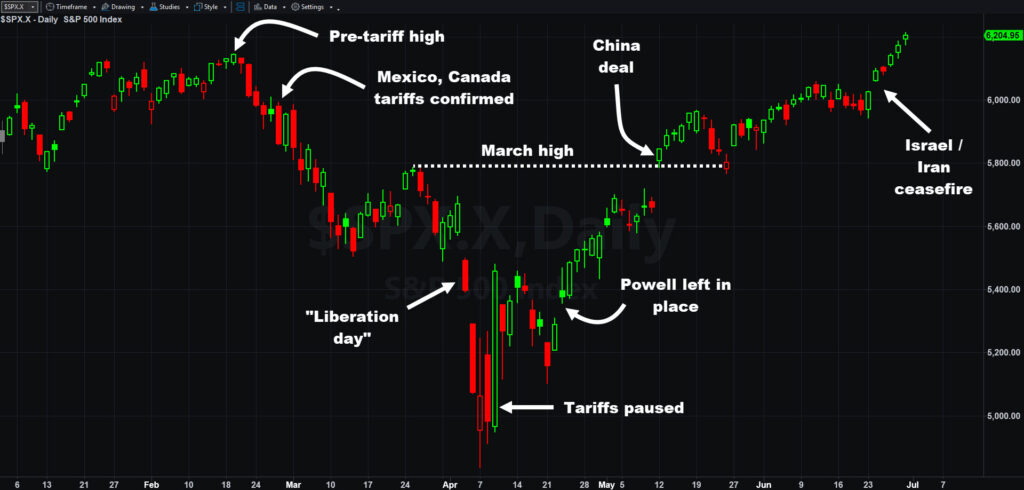Stocks have ended a dramatic and emotional first half of the year, with emotions ranging from terror to bliss.
The S&P 500 rose 5.5 percent between December 31 and June 30. It was the smallest change for a half-year since the end of 2022, so it didn’t look like much on the surface. However, when you consider the 21 percent selloff between February and early April, followed by a 28 percent rebound, the index moved 1,380 points. That was its largest half-year trading range ever, according to TradeStation data.
Trade wars and tariffs were the biggest catalyst but not the only story. An early event was the arrival of China's DeepSeek AI model, which hammered technology as investors worried companies were overspending on hardware. Next came tariffs on North American trading partners Mexico and Canada, followed by even bigger duties on the rest of the world in early April.
That triggered not only broad selling in U.S. stocks, but also Treasuries and the U.S. dollar itself. Markets quickly realized that fewer imports would mean fewer greenbacks getting recycled into the financial system from overseas. Near-panic ensued and investor sentiment fell to the most bearish levels since the financial crisis, according to the American Association of Individual Investors (AAII).

S&P 500, daily chart, showing key events in the first half of 2025.
Treasury Secretary Scott Bessent intervened in early April, persuading Trump to delay the tariffs. That established a floor beneath the market. The president also relented on talk of ousting Federal Reserve Chair Jerome Powell, further calming nerves. (He's nevertheless remained highly critical of Powell.)
Bessent's next achievement came on May 12, when his announcement of lower tariffs on China drove stocks above their March high.
AI Stays Strong
While political events drove some of the biggest moves, there was also good news from Silicon Valley. Amazon.com (AMZN), Meta Platforms (META) and Microsoft (MSFT) revealed hefty capital expenditures on data centers. Other companies benefited from the spreading AI boom. Let's start with IT hardware names:
Biggest Gainers in the S&P 500 in 1st Half
| Palantir Technologies (PLTR) |
+80% |
| NRG Energy (NRG) |
+78% |
| Howmet Aerospace (HWM) |
+70% |
| Seagate Technology (STX) |
+67% |
| GE Vernova (GEV) |
+61% |
| Source: TradeStation data |
|
- Seagate Technology (STX): Earnings, revenue and guidance beat estimates on April 29. The data-storage company proceeded to enjoy its biggest quarterly gain since 2009.
- Amphenol (APH): The maker of products like ethernet cables beat estimates on April 23 and was at a new all-time high the following week.
- Microchip Technology (MCHP): The maker of switches and controllers rallied after reporting strong numbers on May 8.
- Cisco Systems (CSCO): The networking company beat estimates on May 14 as AI revenue goals were met ahead of schedule.
The AI boom also spread to software companies. Interestingly, two of the biggest beneficiaries were older names that hadn't drawn significant attention for years:
- Intuit (INTU): The owner of QuickBooks and TurboTax jumped to new all-time highs on May 23 after new AI functionality helped results beat consensus. That fueled its biggest monthly gain in over two decades.
- Oracle (ORCL) also surged on June 11 after strong demand for AI drove growth in its cloud-computing business. It jumped more yesterday after a filing cited large orders for its services.
Sell America?
Another major trend in the first half was weakness in U.S. stocks versus the rest of the world. The S&P 500 underperformed other countries like South Korea, Germany and China by wide margins. Some of the weakness was caused by diversification after years of U.S. outperformance. However some of the move was also associated with capital leaving the U.S. because of tariffs and Washington's growing fiscal deficit. Economic growth missed estimates and Moody's downgraded the U.S. sovereign credit rating, citing higher costs to service the debt.
Biggest Decliners in the S&P 500 in 1st Half
| Deckers Outdoors (DECK) |
-49% |
| Enphase Energy (ENPH) |
-42% |
| UnitedHealth (UNH) |
-38% |
| Lululemon Athletica (LULU) |
-38% |
| Edison International (EIX) |
-35% |
| Source: TradeStation data |
|
That trend made precious metals one of the top groups between the ends of December and June. Gold rallied to a new all-time high. Silver hit levels last seen in 2012 and platinum broke free of a multiyear range.
Communications stocks were the top sector overall, supported by META's 26 percent move. (That was the biggest gain of any trillion dollar stock.) Netflix (NFLX) also rose more than 50 percent thanks to global growth and the success of its ad-based business model.
Industrials were No. 2, powered by Howmet Aerospace (HWM), GE Vernova (GEV) and Uber Technologies (UBER).
Consumer discretionaries were the bottom sector in the first half. Tesla (TSLA) accounted for much of the drop. Apparel companies like Deckers Outdoors (DECK) and Lululemon Athletica (LULU) also struggled with tariff pressures.
Healthcare also lagged as higher expenses weighed on managed-care companies. UnitedHealth (UNH), the world's biggest HMO stock, had its biggest six-month drop since 2008.





